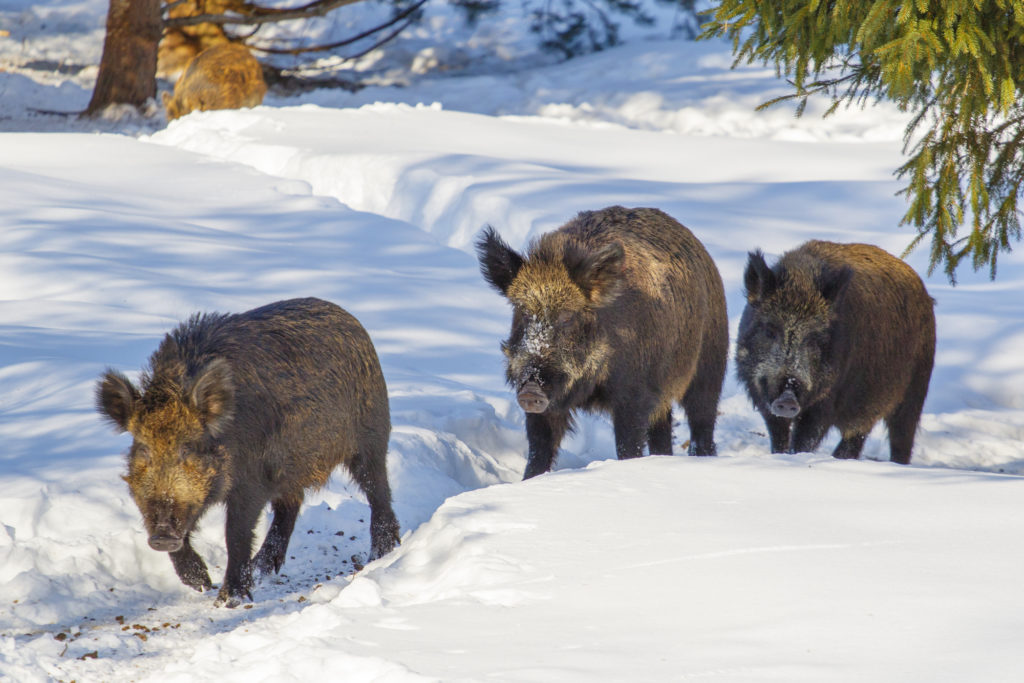Here are the 5 best tips for a successful wild boar hunt!
For wild boar hunters, many factors are decisive for success in the hunting ground. Wild boar hunting is becoming increasingly popular across Europe. This is not least due to the enormous populations of wild boar and the associated damage caused by game. But for a successful hunt, in addition to right equipment, one thing is particularly important: understanding the behavior of the boars and sows. What time of day is most effective? How does the phase of the moon affect their behavior? And what role does the wind play?
1. Time of day
Time of day is one of the elementary things that you should consider when hunting for wild boar. The intelligent animals only venture out of their lair at certain day times. This time varies depending on the hunting pressure in the individual forest areas. In heavily hunted areas, wild boars are therefore often nocturnal. This makes detecting them even more difficult.
2. Variety in time and place
If you want to successfully hunt wild boar, you should try your luck during the winter months. Especially during snowy days, you have a decisive advantage. On one hand, the reflection of the snow improves the visibility at night – and on the other hand, the dark fur of the wild boar clearly stands out against the white surroundings, making them a lot easier to spot.
3. Intelligent animal – Intelligent hunter
You should consider several factors if you want to hunt wild boar successfully. One of the biggest challenges is the intelligent and adaptive behavior of the animal.
Put simply, wild boar act very instinctively. If a hunt is planned from a high seat, you should always cover the raised hide very well. This prevents the odor-sensitive pigs from picking up your scent.
A change of location is also of great importance. If you have been successful in one location, you should think again before visiting this exact spot in the future. The escaped animals will remember the location, associate this specific spot with danger, and will avoid it completely.
So, what should you keep in mind? Adaptation and variation are key. Above all, the time of day and the location of the high seat should be switched up regularly. If the light conditions are optimal, it is advisable to hunt under half moonlight instead of a full moon. The animals are not influenced by the phases of the moon at all. To sum up, being unpredictable is the key to success.
4. The direction of the wind
Environmental influences often determine the success or failure when you are wild boar hunting. The wind is a decisive criterion. Since wild boars have an above-average sense of hearing and smell, it is always advisable to stand against the wind. Another option is to cover up with special, odor-blocking clothing that reduces body odor to a minimum.
Wild boars are particularly sensitive to thunderous days with violent gusts of wind. Such conditions are extremely unfavorable for hunting, as such wind conditions unsettle the game.
5. Correct identification
There are numerous mistakes you can make when hunting wild boar. For instance, before a shot is even fired, you must precisely identify the game. Especially when you have to shoot from a distance, misjudgments are common and inevitably lead to missed shots. Here are three classic challenges when identifying game – and how to overcome them.

Challenge 1: They look bigger than they are
Probably the most common mistake in wild boar hunting! Within seconds, a supposed young boar shoots through the snow. At least at first glance. Within a very short time, the view can become distorted and what previously looked like a young boar could be a yearling after all. Uncertainty spreads. So, what do you do?
A look under the animal’s belly usually provides certainty and is necessary to be able to identify a yearling correctly. It is the only way to answer the question of whether you are looking at a large young boar, a yearling or a leading sow. Once you spot a milk line you can easily identify the animal correctly.
Challenge 2: The lead of a drove is wrongly identified
This is also one of the classic mistakes made when hunting wild boar. If the drove consists only of piglets and one adult sow, the lead is very clear. If the drove consists of several sows and piglets, it becomes more difficult. Male piglets from the previous year, the yearlings, never lead a drove – they separate from the group before they mature. The drove therefore consists mostly of adult sows with piglets. So, if you don’t want to accidentally shoot the leading sow, you have only one choice: master challenge number one and catch a good glimpse of the belly.
Challenge 3: Searching for a leading sow
If you want to identify a sow correctly, you must always get a good look at the body of each animal. If you want to eliminate any doubts when approaching a sow, it’s best to keep an eye out for a run or a game path. If the animals move from one field to the next, the view of the belly of the wild boar is unobstructed making it easier for you to identify whether it’s a yearling, a sow or a piglets.
Waidmannsheil!